FILAMENTOUS ALGAL SPECIES COMMON IN ACID AND SOFT WATERS.
Descriptions of operational taxa found in field studies in Scotland.
(Loch Ard area of The Trossachs, Galloway,
Islay, Morar and Glenelg:
Kinross, 1985, 1991 and unpublished data)
LIST
Rhodophyta:Batrachospermum
Lemanea
Audouinella (=Rhodochorton )
Audouinella (green)
Taxon no. (1-50 as referred to in Kinross et al, 1993)
Rhodophyta
1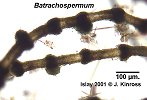 2
2 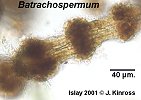 3
3  4
4  5
5 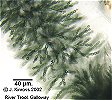
This is a large alga. It may be readily seen with
the naked eye and its form is visible with a hand lens or low power microscopy.
The colour may be dark brown or deep turquoise. The main axis of the plant
is composed of many layers of cells with whorls of branches emerging at
intervals giving a beaded appearance. The plant is invested in slippery
mucilage, making the gathering of samples quite difficult.
Images 1-3 were gathered in late winter, whereas 4 and 5, gathered later
in the season, show more extensive growth of the side branches into whorls
(which have been likened to a bottle-brush).
16 = Lemanea

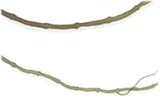



This is also large enough to be readily seen with the naked eye. It grows firmly attached to rocky substrata in locations exposed to permanently rapid currents. The thallus is multiseriate, tough and wiry (younger filaments feel softer, however), greyish-green in colour, tapering towards the tip with swellings (nodes) at intervals.
17 = Audouinella (=Rhodochorton )
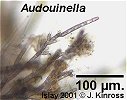

This Rhodophyte frequently forms a short pinkish turf on stones in fairly fast-flowing water. The filaments are branches, blunt-ended, with cells approximately 17Ám in diameter and a pinkish coloured chloroplast distributed around the periphery of the cell.
18 = Audouinella (green)
Less frequently a variation is found in which the chloroplast is greyish or grey-green. This may be not a separate species, but a juvenile stage of Batrachospermum , or possibly Lemanea..
John Kinross
